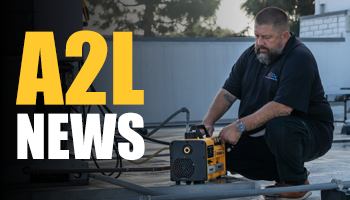
By now you’ve probably heard about the big change impacting the HVACR industry – a transition to A2L refrigerants with a low global warming potential (GWP) and phase down in production of hydrofluorocarbon (HFC) refrigerants with a high GWP. This change in refrigerant production, the new HVAC equipment required and resulting new regulations are being mandated by the EPA in execution of the AIM Act. Exactly how and when these new regulations impact you will vary based on the type of systems you install and service. Here’s a snapshot of what’s coming!
HFC Equipment Availability
Last year, the EPA extended the sell through date of higher-GWP HFC split system heat pump and air conditioning systems by a year to January 1, 2026. This extension helps alleviate any stranded inventory of HFC equipment. Therefore, if you are doing a new installation of a residential and light commercial system you will likely not be affected over the next year. A “new” installation means that you’re replacing 100% of specified components, increasing the cooling capacity, or replacing 75% of the evaporators and 100% of its compressor racks, condensers, and connected evaporator loads. If you are buying parts for repairs or servicing of existing HFC systems, then it’s business as usual.
If you work in refrigeration, the dates are slightly different. Self-contained refrigeration units can be sold until Jan 1, 2028. However, if you work on cold storage warehouses or supermarket refrigeration with remote condensing units, full system installs with HFC refrigerants are prohibited after Jan 1, 2026, and Jan 1, 2027, respectively.
The technology transition for variable refrigerant flow systems is moving on a slower schedule. There may be some relief from current implementation dates, but the EPA has not yet communicated those dates.
A2L Equipment & Install Changes
New A2L refrigerant regulations will impact the design, installation and line set of systems. For example, due to the flammable nature of A2L refrigerants, a leak mitigation strategy must be in place to detect refrigerant leaks throughout the refrigeration circuit, including building shafts containing an A2L line set. Systems must automatically detect the leak, shut down, and turn on the blower fan to dissipate the refrigerant. All A2L line sets will also require “Risk of Fire” labels. Consult with your local building officials to understand all the new code requirements for A2L system installations.
You have likely already seen the gray A2L cylinders with a red band or stripe to indicate the presence of the mildly flammable refrigerant. To further differentiate from HFC refrigerant tanks, A2L cylinders require a reverse thread adapter.
Recover, Recycle, Reclaim
Under the AIM act, the EPA outlines their goals to bolster the supply of HFC refrigerants in the United States by supporting recycling and reclamation, and mandating leak repair provisions for certain appliances. By 2028, the EPA is requiring reclaimed refrigerant be used for servicing existing equipment in addition to initial charges in certain systems for HVACR and heat pump equipment. This means that there is a need to recover and return HFC refrigerants to distribution. Note that most distributors have eliminated fees for exchanging tanks and if you are able to reclaim and not mix refrigerants, you may receive money as well.
Documentation
It remains important to maintain your records when disposing of refrigerant including location and date of recovery, type of refrigerant recovered, monthly totals of amounts recovered, and amounts sent for reclamation. When servicing appliances with 50 or more pounds of HFC refrigerants, technicians must also provide owners with documentation that includes the amount of refrigerant added and any leak inspections and tests performed.
Stay Ahead of the A2L Transition
As everyone in the industry transitions to this new landscape, Fieldpiece is doing everything to ensure our tools are ready for the transition. Visit our A2L page on fieldpiece.com to see all the tools that are A2L compatible. As regulations, timelines and the industry evolve, we’ll be here to help everyone work easier, faster, and better.